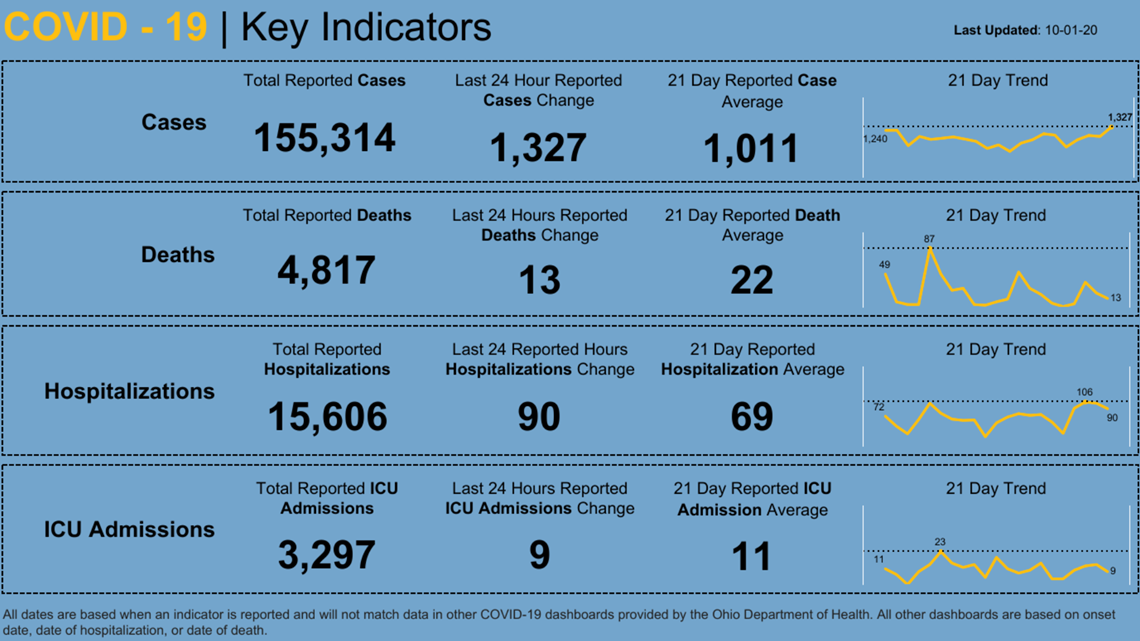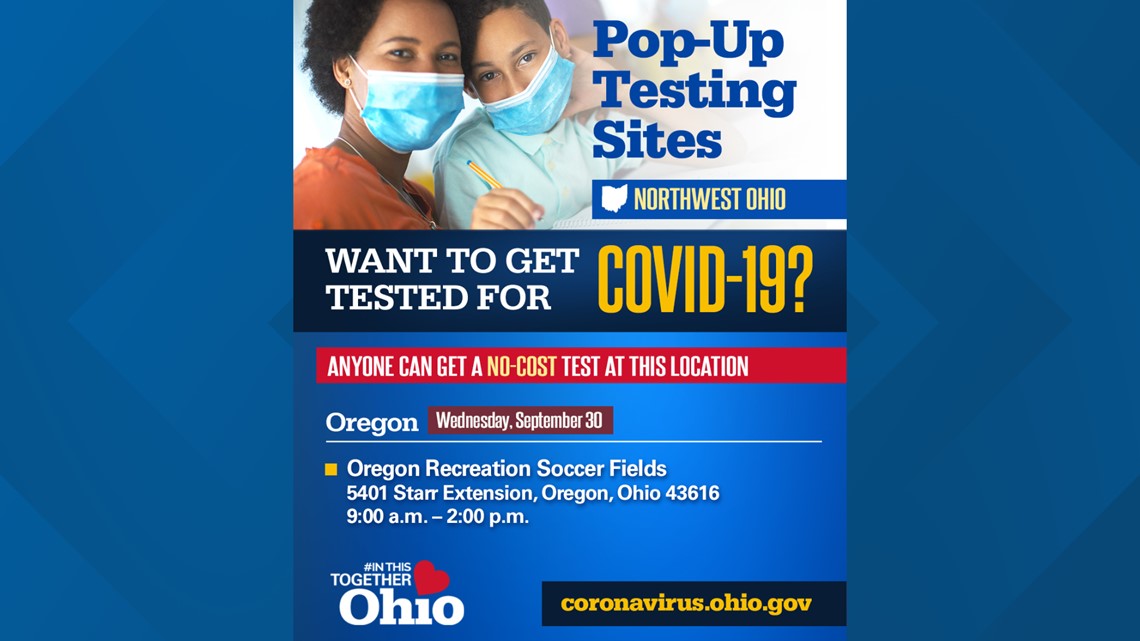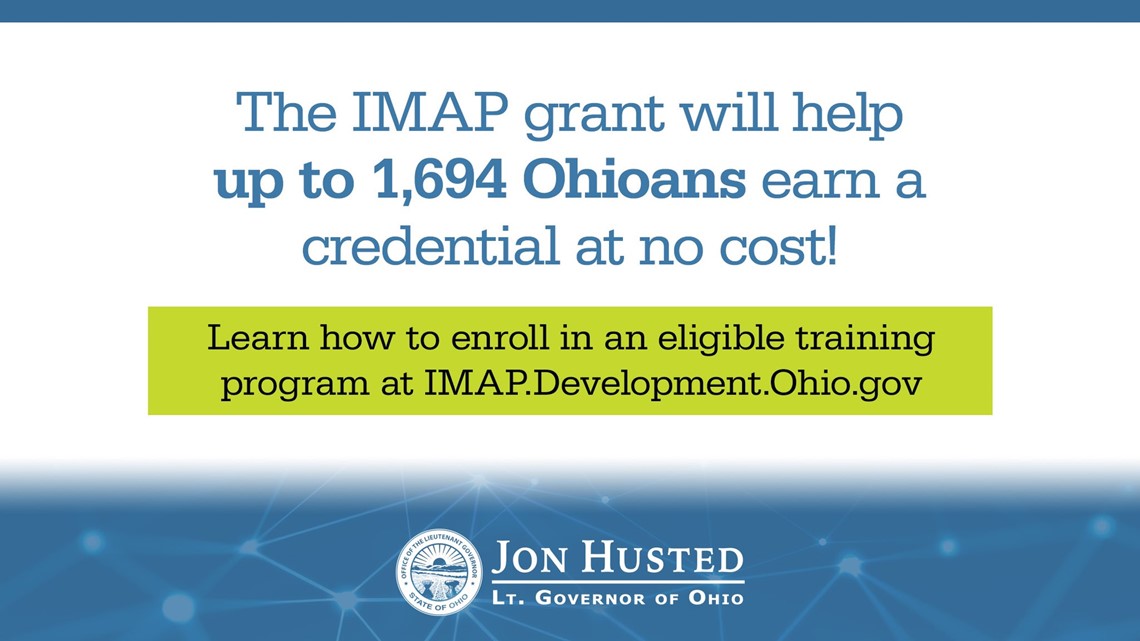COLUMBUS, Ohio — Ohio Gov. Mike DeWine is set to address the state Thursday afternoon, with new information on his administration's response to the COVID-19 pandemic.
In addition to the latest coronavirus data, DeWine discussed the first presidential debate, saying it wasn't the country's "finest hour."
Here's a breakdown of what was discussed.
THURSDAY
KEY METRICS
Here are the coronavirus trends as reported by the Ohio Department of Health on Thursday:
- 1,327 new cases reported compared to 21-day average of 1,011
- 13 new coronavirus-related deaths compared to 21-day average of 22
- 90 new hospitalizations compared to 21-day average of 69
- 9 new ICU admissions compared to 21-day average of 11


CASES PER 100,000 PEOPLE
Putnam County dropped back down to the second spot on Tuesday on DeWine's list of counties ranked in order of those with the most cases per 100,000 people to the least. It was reported to have 230.4 cases per 100,000 over the last two-week period.
In northwest Ohio, Wood County remained in the top 10 as well at fifth on Thursday, with 189 cases per 100,000 people.
Henry County fell in the seventh spot, with 177.7 cases and Fulton came in ninth with 159.
All of the counties are well above the Centers for Disease Control and Prevention's threshold of just 100.
PUBLIC HEALTH ADVISORY MAP
There were 11 red counties on Thursday, the most at any point in September.
Four counties were added, although none of them were from northwest Ohio.
Southwest Ohio has seen a number counties creep back into the Level 3 (Red) category, DeWine said.
However, Putnam County has stayed at the Level 3 (Red) category for a few weeks. This has been attributed to spread in small gatherings as well as an issue with people failing to follow quarantine protocol.
ANTIBODIES
Dr. Abby Norris-Turner of The Ohio State University joined in on Thursday's conference to discuss the antibody testing that was conducted on behalf of ODH.
Norris-Turner said that the purpose of this project was to calculate two specific estimates:
- How many people actively had coronavirus at that point in time
- How many people had coronavirus in the past
The way they did that, she said, was selecting 240 census tracks throughout the state, randomly sampling households. Once they had that list of households, they sent people a letter explaining the study and giving them the option to opt out.
Those who consented went on to give biological samples. First, a blood sample was taken, which was looking for antibodies. Then, a nasal swab was taken, which tested for the active virus.
From July 9 until July 28, 727 Ohio adults participated. For active disease, 0.9% of the sample had active COVID-19. For antibodies, they found 1.5% of people in the study had evidence of previously having the virus.
Those numbers don't tell us who's been infected since the onset of the pandemic, it only goes about as far back as April, Norris-Turner said.
While there isn't much to compare it to, she said these findings line up with what the American Red Cross has reported and is similar to the CDC.
The data from this study can't give a precise number, Norris-Turner said. She did say, however, that the prevalence of the virus among Ohio adults is very low; some hundreds of thousands have had it. However, on the flip side, this means a large number of people, millions of Ohioans, are still susceptible.
Norris-Turner said that most people will no longer have detectable antibodies for longer than three months. What that means after that period, is still an open question. It could be, that other parts of their immune system are still active. However, those aren't being measured, so it is unclear how effective they may be after that three-month time frame.
"COVID-19 continues to surprise us, so we shouldn't make any optimistic or pessimistic predictions about short or long-term immunity to disease," she said.
RELATED: Afternoon Tea: July 31, 2020
PRESIDENTIAL DEBATE
DeWine took time out of Thursday's conference to address Tuesday's presidential debate. He expressed pride in the Cleve
"However, the debate itself was certainly not our country's finest hour," DeWine said.
He said that he hopes the next debate will focus on the country's future and the substantive issues facing the United States.
DeWine stated that he supports President Trump, applauding him for the number of appointments he's made during his term, including his most recent nominee for the United States Supreme Court, Amy Coney Barrett.
However, DeWine noted that he's known Democratic nominee Joe Biden for many years, and that he knows Biden also wants what is best for this country, despite the policy disagreements they may have.
"The name-calling by both candidates is simply not helpful the name-calling by both candidates is not helpful," DeWine said.
He said that while we all watched the debate through our own political lense, he said that there are certain things Americans have the right to see in these events going forward.
"What is needed in the next debate is a robust, energetic debate on the challenges the next president will face and as in presidential debates in the past, each candidate has the obligation to articulate a vision for the future of this country; to articulate what kind of a country that candidate believes we should be leaving to our children, our grandchildren and our great-grandchildren."
DeWine said there are fringe groups on both ends of the political spectrum that do not share the values of the United States.
"There are haters. There are people who hate Jews, Muslims, African-Americans... the list could go on and on. There's no place for that. There's no place for that in America," DeWine said. "There are also people, there are people, who believe that violence is a way to achieve political ends. That is not right."
DeWine called for unity Thursday, despite the growing tension between the country's main political parties.
"We cannot let these fringe groups on the right or left divide us. We cannot let them into that system when they preach violence, when they preach hate," he said.
DeWine assured Ohioans that there will be a fair and orderly election come Nov. 3, saying there is a "sanctity" to the state's election process.
ELECTION REMINDERS
- Last day to register is Monday, Oct. 5.
- You can vote in-person from 6:30 a.m. - 7:30 p.m. on Nov. 3. Find your polling place here.
- You can vote early starting Tuesday, Oct. 6. Click here to see hours and locations.
- You can vote absentee. Send your absentee request form to your county's board of elections no later than Oct. 31, although Secretary of State Frank LaRose suggests getting that in by Oct. 27 to be safe. Once you receive your ballot, fill it out and send it back. It should be postmarked no later than Nov. 2. You can also drop it in your county's drop box no later than 7:30 p.m. on Nov. 3.
DeWine said that one of the things this country has done well is the transfer of power after an election.
"However emotional people get, when the results are in... when they're in, people will accept it. They might not like, but they'll accept it. We're Americans," he said.
TUESDAY
KEY METRICS
On Tuesday, here were the coronavirus trends reported by the Ohio Dept. of Health:
- 1,105 new cases of coronavirus compared to 21-day average of 996
- 37 coronavirus-related deaths compared to 21-day average of 23
- 106 new hospitalizations compared to 21-day average of 69
- 13 new ICU admissions compared to 21-day average of 11
CASES PER 100,000
Putnam County jumped back up to the top spot on DeWine's list, ranking Ohio's 88 counties in order of those with the most cases per 100,000 people to the least. The county was reported to have 286.5 cases per 100,000 people over the last two weeks.
Wood County jumped up the list as well, to the fifth spot after staying out the top 10 for a number of weeks. Wood reportedly had 203.3 cases per 100,000. More than double the Centers for Disease Control and Prevention's threshold of 100.
Henry County also stuck around in the top 10, in the ninth spot, with 174 cases per 100,000 people.
WASTEWATER
Rebecca Fugitt, assistant chief of the Bureau of Environmental Health and Radiation Protection at ODH joined in on Tuesday's meeting to discuss testing wastewater for gene fragments of COVID-19.
Fugitt said that because people shed the virus early when infected, a significant sustained increase of these gene fragments in a community's wastewater could be an earlier indicator of a pending increase in a certain area's COVID-19 cases.
Research suggests that experts can see an increase in wastewater three to seven days before they see an increase in cases.
Currently, her team is monitoring 36 cities, with the plan to add an additional 25 cities in the next month.
Fugitt noted an increase in gene fragments found in Lucas County, specifically in Oregon. Due to this, a pop-up testing site has been set up at the Oregon Recreation Soccer Fields on Wednesday. The service is free and will be open from 9 a.m. until 2 p.m.


PRISONS
The Ohio Department of Rehabilitation and Correction Director Annette Chambers Smith discussed how wastewater monitoring plays a role in a new testing plan to help limit virus spread in Ohio's prisons at Tuesday's conference.
So far, Smith said, the information has been used to decide how many cohorts can be together as well as whether or not to allow visitors.
On Tuesday, however, Smith issued an order requiring employees to get tested when certain indicators, like wastewater and positivity of inmates and staff, are triggered. She noted that testing will not be required if there are no indicators. This new protocol will begin Oct. 6.
Smith said when there is a staffing shortage and people are working doubles, they don't want to go somewhere else to get a test. She said her new order will bring testing to them regularly.
In Ohio, there are 79 prison employees who are currently positive for COVID-19, along with 266 inmates.
One-third of Ohio prisons don't have any signs of the virus at all, however.
OHIO MEDICAID
DeWine said Tuesday that his team has developed a new vision for Ohio’s Medicaid program, focusing on people and not just the business of managed care. This is the first major overhaul of Medicaid in 15 years.
On Wednesday, a new application will open for businesses interested in providing managed care plans for children and adults within the Medicaid program. DeWine said he believes the selected plans will be an essential piece in improving the health and lives of millions of Ohioans.
Not only will selected plans work with his administration to build better systems of care, he said, but they also play a special role in helping their members develop good health habits.
If you are currently covered by Medicaid, DeWine said that any changes to Ohio’s managed care plans will not disrupt your coverage or access to care.
The Department of Medicaid will also be issuing a second managed care application later this fall to specifically serve children who have complex behavioral health needs.
DeWine's new managed care program for children with complex needs - called Ohio RISE – will work to build up evidence-based care coordination and behavioral health programs throughout the state, in the hopes to ensure access for more children and better outcomes.
MICRO-CREDENTIAL ASSISTANCE PROGRAM
The Individual Micro-credential Assistance Program, IMAP, reimburses training providers up to $3,000 for each completed technology-focused credential issued, up to $250,000 per provider, Lt. Gov. Jon Husted announced Tuesday.


Additionally, the Free Application for Federal Student Aid – also known as FAFSA - opens on October 1. All students, high school seniors, current students, and adults interested in attending or returning to college should complete it.
Each year, Ohio families miss out on available financial aid because they don’t complete the FAFSA. It is estimated that approximately 39% of students eligible for financial aid do not currently complete the FAFSA.
Learn more by clicking here.



